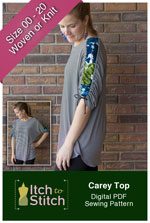digital chemainus top sewing pattern
The Chemainus is a relaxed-fit woven top with dolman-style, cuffed short sleeves that radiates summer casual chic. You will feel so put-together in it! Use a solid-color fabric to make an understated Chemainus, or use a colorful, fun fabric that brightens up your day.
-
Itch to Stitch Digital Patterns
This style is provided as a digital pattern. It may be printed on home printers that use either 8 1/2" x 11" or A4 paper or at a print shop that can print A0-sized pattern sheets. When you complete your order, you will be provided with a unique code to instantly download the pattern. See our digital product policy for full details.
All Itch to Stitch patterns come as multiple PDF files consolidated within a single .zip file. Download and save the .zip file to a computer to access the PDF files. Downloading .zip files to mobile devices is not recommended as most phones and tablets cannot open them.
Description
The Chemainus is a relaxed-fit woven top with dolman-style, cuffed short sleeves that radiates summer casual chic. You will feel so put-together in it! Use a solid-color fabric to make an understated Chemainus, or use a colorful, fun fabric that brightens up your day.
Chemainus Top features:
- Options for A, B, C, D and DD cups
- Bust darts
- Dolman-style, cuffed short sleeves
- Buttoned partial front placket
- Center front and center back pleats
- Shoulder insets for color-blocking opportunity
- Shirttail hem
- Bias-bound neckline
- Layers feature (print only the sizes you need)
Sizes: 00 – 20
Suggested Fabrics
Primary Fabric: Use lightweight woven fabric with a soft or fluid drape with no stretch. Rayon challis, rayon twill, bamboo blend, lawn, voile, batiste and silky fabric are good choices.
Contrast Fabric: Use lightweight, woven fabric with no stretch. Rayon challis, rayon twill, bamboo blend, shirting, voile, batiste and silky fabric are good choices. You can use the same fabric as the primary fabric.
Interfacing: Use very lightweight fusible woven or weft insertion interfacing.
Size Chart, Finished Measurements, and Fabric Requirements
Click to enlarge the final images at above right.
Choosing your Size
- Determine your cup size—subtract the circumference of your over bust from the circumference of the fullest part of your bust. If the rounded difference is 1″ (2.5 cm), use A cup; 2″ (5 cm), use B cup; 3″ (7.5 cm), use C cup; 4″ (10 cm), use D cup; 5″ (12.5 cm), use DD cup.
- After determining the cup size, compare your bust circumference (fullest part) to the “Body Measurements” table. Using the corresponding row for your cup, choose the size that best fits your bust. If you are between sizes, choose the smaller size if you like your garment more fitted; otherwise, choose the bigger size.
- Compare your hip circumference (widest part) to the “Body Measurements” table. Choose the size that fits your hip best. If you are in between sizes, choose the smaller size.
- The waist is designed to be very relaxed; hence, you do not need to choose a size based on your waist.
- It’s OK to use different sizes for the bust and hip. (see instructions for details)
- If you are taller or shorter than 5’6” (168 cm), you should consider lengthening or shortening the top (see instructions for details).
- It is highly recommended that you check your fit by making a test garment with inexpensive fabric that has similar weight as your final garment fabric.
-
Average rating: (5 of 5) based on 1 reviews
Chemainus TopReviewed by Hilary (✓ Verified Buyer) on 10/16/2020This is an interesting and easy top to sew. It has a good cup size range and clear instructions. I have made 3! The first one was a little too roomy so made two more in a smaller size. I sewed them in viscose with light weight cotton contrast. Now waiting for warm weather to arrive in NZ to wear them.1 of 1 customers found this helpful.Was this helpful?









